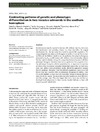Please use this identifier to cite or link to this item:
https://accedacris.ulpgc.es/handle/10553/43552
| DC Field | Value | Language |
|---|---|---|
| dc.contributor.author | Monzon Argüello, Catalina | en_US |
| dc.contributor.author | Consuegra, Sofia | en_US |
| dc.contributor.author | Gajardo, Gonzalo | en_US |
| dc.contributor.author | Marco-Rius, Francisco | en_US |
| dc.contributor.author | Fowler, Daniel M. | en_US |
| dc.contributor.author | DeFaveri, Jacquelin | en_US |
| dc.contributor.author | Garcia de Leaniz, Carlos | en_US |
| dc.date.accessioned | 2018-11-21T16:04:06Z | - |
| dc.date.available | 2018-11-21T16:04:06Z | - |
| dc.date.issued | 2014 | en_US |
| dc.identifier.issn | 1752-4563 | en_US |
| dc.identifier.uri | https://accedacris.ulpgc.es/handle/10553/43552 | - |
| dc.description.abstract | Invasion success may be expected to increase with residence time (i.e., time since first introduction) and secondary releases (i.e., those that follow the original introduction), but this has rarely been tested in natural fish populations. We compared genetic and phenotypic divergence in rainbow trout and brown trout in Chile and the Falkland Islands to test the prediction that adaptive divergence, measured as PST/FST, would increase with residence time and secondary releases. We also explored whether interspecific competition between invaders could drive phenotypic divergence. Residence time had no significant effect on genetic diversity, phenotypic divergence, effective population size, or signatures of expansion of invasive trout. In contrast, secondary releases had a major effect on trout invasions, and rainbow trout populations mostly affected by aquaculture escapees showed significant divergence from less affected populations. Coexistence with brown trout had a positive effect on phenotypic divergence of rainbow trout. Our results highlight an important role of secondary releases in shaping fish invasions, but do not support the contention that older invaders are more differentiated than younger ones. They also suggest that exotic trout may not have yet developed local adaptations in these recently invaded habitats, at least with respect to growth‐related traits. | en_US |
| dc.language | eng | en_US |
| dc.relation.ispartof | Evolutionary Applications | en_US |
| dc.source | Evolutionary Applications [ISSN 1752-4563], v. 7 (8), p. 921-936 | en_US |
| dc.subject | 2510 Oceanografía | en_US |
| dc.subject.other | Microsatellites | en_US |
| dc.subject.other | Naturalization | en_US |
| dc.subject.other | Oncorhynchus mykiss | en_US |
| dc.subject.other | Phenotipic divergence | en_US |
| dc.subject.other | Rapid evolution | en_US |
| dc.subject.other | Salmo trutta | en_US |
| dc.subject.other | Selection | en_US |
| dc.title | Contrasting patterns of genetic and phenotypic differentiation in two invasive salmonids in the southern hemisphere | en_US |
| dc.type | info:eu-repo/semantics/article | es |
| dc.type | Article | es |
| dc.identifier.doi | 10.1111/eva.12188 | en_US |
| dc.identifier.scopus | 84908070739 | - |
| dc.contributor.authorscopusid | 22951371200 | - |
| dc.contributor.authorscopusid | 10939334900 | - |
| dc.contributor.authorscopusid | 6603798118 | - |
| dc.contributor.authorscopusid | 55372816700 | - |
| dc.contributor.authorscopusid | 56388277100 | - |
| dc.contributor.authorscopusid | 39261209200 | - |
| dc.contributor.authorscopusid | 15623072100 | - |
| dc.description.lastpage | 936 | - |
| dc.identifier.issue | 8 | - |
| dc.description.firstpage | 921 | - |
| dc.relation.volume | 7 | - |
| dc.investigacion | Ciencias | en_US |
| dc.type2 | Artículo | en_US |
| dc.identifier.ulpgc | Sí | es |
| dc.description.sjr | 2,356 | |
| dc.description.jcr | 3,896 | |
| dc.description.sjrq | Q1 | |
| dc.description.jcrq | Q1 | |
| dc.description.scie | SCIE | |
| item.grantfulltext | open | - |
| item.fulltext | Con texto completo | - |
| crisitem.author.fullName | Monzon Argüello, Catalina | - |
| Appears in Collections: | Artículos | |
SCOPUSTM
Citations
15
checked on Jun 8, 2025
WEB OF SCIENCETM
Citations
14
checked on Jun 8, 2025
Page view(s)
59
checked on Mar 2, 2024
Download(s)
151
checked on Mar 2, 2024
Google ScholarTM
Check
Altmetric
Share
Export metadata
Items in accedaCRIS are protected by copyright, with all rights reserved, unless otherwise indicated.
